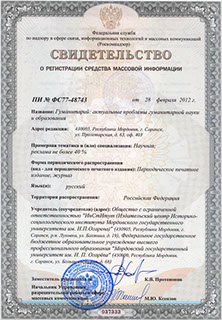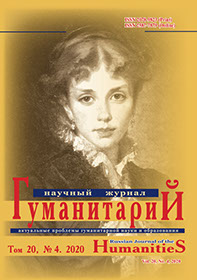ГуманитариЙ актуальные проблемы гуманитарной науки и образования
Russian Journal of the Humanities
ISSN 2078-9823 (Print)
ISSN 2587-7879 (Online)
Navigation
ISSN 2078-9823 (Print), ISSN 2587-7879 (Online)
DOI: 10.15507/2078-9823.052.020.202004.389-401
УДК 316.75:130.2
Alexey S. Bulygin1, Mariya A. Stashneva2
1 Institute of Sociology of the Russian Academy of Sciences (Volga Region Branch) (Nizhny Novgorod, Russia),
e-mail: nrcsad911@yandex.ru
2 Independent researcher (Nizhny Novgorod, Russia),
e-mail: science-box@bk.ru
Formation of the Image of Russian State Security Agencies in the Public Consciousness: Symbolic Potential of Memorial Objects
Introduction. The effectiveness of the work of law enforcement agencies largely depends on the support of population and the image of the agency in the public consciousness. Over the course of a century of the agency’s activities, the image of Russian special services and their leaders has been constantly transformed, that left its mark on the installation and demolition of monuments. The purpose of this article is to study the relationship between the public perception of the activities of Russian state security bodies and the image of their leaders, reflected, among other things, in memorial objects. Materials and Methods. The study is based on the principles of determinism, objectivity, historicism, consistency. The article uses an interdisciplinary approach that integrates the achievements of a number of humanities on the subject under study. The theoretical basis of the study was the issues of domestic and foreign philosophers, historians, political scientists. Important source groups were electronic media reports and opinion polls. For the interpretation of the latter, a method of secondary analysis of data from sociological studies was used. Results. The ambiguous attitude of various social forces to the activities of state security bodies finds its expression in the struggle for the existence of memorial objects in memory of their leaders. The most discussed historical figures in this context are Felix Dzerzhinsky, Lavrenti Beria and Yuri Andropov. In recent decades, there has been an increase in positive assessments of these statesmen in the public mind and scientific community. Nevertheless, the most significant initiatives in the field of commemoration of the activities of special services (in particular, the return of the Dzerzhinsky monument to Lubyanka Square) have not yet been implemented. Discussion and Conclusions.
A public reminder about the heads of state security agencies stimulates a reassessment of historical events in the public mind and positively affects the image of the agency. The current moment seems to the authors favorable to perpetuate the achievements of security agencies.
Keywords: history of Russian state security agencies, image of state security agencies, collective memory, commemoration, symbolic policy, monuments to Felix Dzerzhinsky, monuments to Lavrenti Beria, monuments to Yuri Andropov.
For citation: Bulygin A. S., Stashneva M. A. Formation of the Image of Russian State Security Agencies in the Public Consciousness: Symbolic Potential of Memorial Objects. Gumanitarian : aktual’nye problemy gumanitarnoi nauki i obrazovaniia = Russian Journal of the Humanities. 2020; 20(4): 389–401 (In Russ.). DOI: 10.15507/2078-9823.052.020.202004.389-401.

© Ogarev Mordovia State University. History and Sociology Institute, 2017
68, Of. 411, Bolshevistskaya St., 430005, The editorial office of the scholarly journal «Russian Journal of the Humanities»
Tel.: (8342) 24-25-90; 27-07-11, Fax: (8342) 24-25-90, E-mail: jurnal-econom-hist@isi.mrsu.ru
Designed by A. Napalkov, Email: napalkov@isi.mrsu.ru

